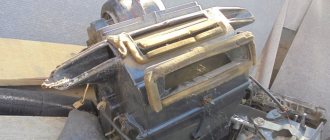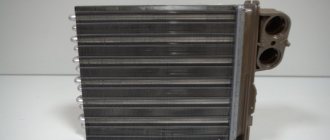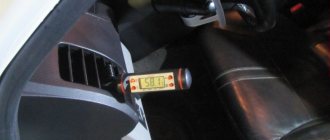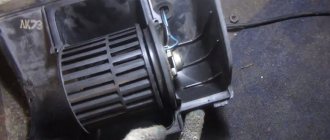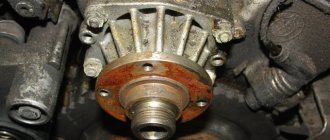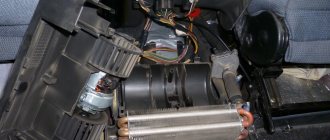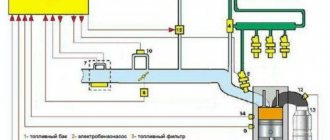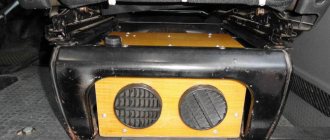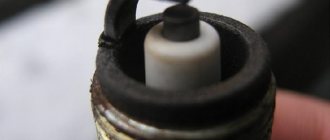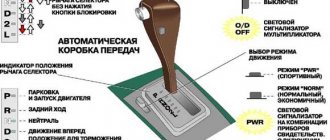Does the stove on the VAZ 2107 heat poorly?
And the cold is coming again.
For those whose interior heater on a VAZ 2107 does not heat well, the question arises - how to make the “stove” heat better? Most 7 car owners are dissatisfied with the operation of the stove or interior heater. Indeed, the stove efficiency of the classics of this brand is very low. But this problem can be solved by modifying the stove yourself. To improve the operation of the heater, you do not need special tools or skills; everything is done using improvised means.
Why the stove on the VAZ 2107 does not heat well, reasons:
A common cause is an underheated engine.
Signs: The temperature gauge is in the white zone, the engine takes a long time to warm up. At an outside temperature of -20, within 8-10 minutes of idling the engine, it should warm up to 40-50 degrees (the very beginning of the white zone of the temperature gauge).
If the temperature rises less, it’s bad (the thermostat is faulty), higher is good. Next, you need to drive in 1-2 gears, and in 5-8 minutes the temperature should rise to 80 degrees (the border of the green and white zones). If the engine has not warmed up to 80, replace the thermostat!
Air in the cooling system.
First of all, you need to check the antifreeze level in the expansion tank and the serviceability of the radiator cap. If the radiator cap is faulty, air will remain in the system, which will result in poor circulation of coolant and, accordingly, cold air in the cabin.
The stove blows poorly to the left
The lower flap is completely open, or its latch is broken. To fully blow the glass, this damper must be closed. If it does not lock, you can use an elastic band, hooking it onto the “choke” handle, or somewhere else.
Heat does not flow inside the cabin due to several reasons:
- The thermostat has become unusable. If the thermostat is faulty, cold air will flow into the car interior when the engine is cold. And when the internal combustion engine is warmed up, the stove will properly perform its main purpose. The thermostat cannot be repaired, so it should be replaced according to the instructions.
- An air lock, which sometimes occurs when the coolant is replaced incorrectly, can also cause ineffective operation of the car’s heating system. The solution to this problem is simple - place your “iron four-wheeled horse” on a flat area and gradually remove the resulting air plug, slowly releasing the air.
- Quite often, in car models with a fairly high mileage, the honeycombs on the radiator become clogged, which damages the heating system. The resulting scale becomes an obstacle to normal fluid circulation, so exclusively cold air enters the cabin. Careful descaling or installing a new radiator will help eliminate such problems.
A training video tutorial in the virtual space will help you find the cause of a car heater breakdown, which can be viewed by everyone at a time convenient for visitors.
Modification of the VAZ 2107 stove so that it heats better.
As practice shows, the stove radiator gives off a sufficient amount of heat and its improvement is not required. This means that in order to increase the efficiency of the heater, the airflow system needs to be modified. Coat all air ducts with sealant, especially at their connections. This especially applies to VAZ 2105 - 2107 cars, due to their design features of the air ducts.
Replacing the stove motor.
The stove can be improved by installing a snail instead of an engine with an impeller, as used in VAZ 2108-2109 models. This tuning will increase air flow and reduce noise. The motor used in these models differs from the seven in its increased speed and greater power. To install it, a slight modification to the stove body will be required - due to its larger size, it is necessary to remove the comb, which directs the air flow to the feet.
You can leave the original impeller, but you need to enlarge the hole in it with a diameter of up to 7 mm, for the motor shaft from the figure eight.
Such modification of the stove also requires replacing the switch and resistor. Both parts are taken from the same model as the motor. The VAZ 2107 switch is designed for a lower current, and when used with a powerful engine it can simply melt. The native resistance of the VAZ 2107 will not allow the motor to operate at full power, which is why the resistor is changed.
We start by completely disassembling the heater housing. Almost everything is cut off from the bottom of the stove, except for the fasteners and frame. Next, we make the body for the snail. For this purpose, you can use any durable material - polycarbonate, plastic, plexiglass, etc. The four walls of the future body are cut out of the material (that you have chosen) and screwed to the bottom of the stove.
After all the steps done, we put the lower part on the middle one, first remove the diffuser. The dimensions must be adjusted so that the snail fits exactly into the body and does not protrude beyond the radiator mounts located on the middle part.
At this stage of work, you should pay special attention; if the body turns out to be large, then you will not be able to install the stove in its normal place. After accurately adjusting the dimensions of the new housing, all joints must be coated with sealant.
Let's take care of the air ducts. You can use commercially available plumbing hoses and cuffs. In the new stove body, holes of a suitable diameter for the cuffs are cut in the bottom, on both sides. Hoses are installed in them - the side ones are connected to the right and left air ducts, the lower ones away from the legs, to exhaust the warm air flow.
To heat the rear passengers, you can additionally install a pair of longer hoses. The amount of heat given off by the stove radiator and the power of the snail are quite enough for everything. The places of the side air ducts and hose connections are coated with sealant to prevent loss of warm air.
Such a modification will increase the efficiency of the stove on the VAZ 2107 by 2-3 times, both in the quality of glass blowing, a large flow of warm air does not allow the windows to fog up, and in heating the interior. This modernization of the interior heater is available to everyone and does not require large expenses.
Conversion of the VAZ-2108 stove (snail) to VAZ-2107: video
Note: it should be remembered that when installing the volute and motor, the switch must be replaced. Make sure the heater fuse has the current rating required to operate the modified heater.
Muffler tuning
The exhaust system of VAZ cars of the “classic” series (2101–2107) consists of three parts: the exhaust pipe (“pants”), a resonator and a muffler.
Direct-flow muffler: device, advantages, installation
Many owners of “kopecks” do not leave the exhaust system of their cars without improvements, replacing the standard muffler with a direct-flow muffler, or simply adding it to an existing one, achieving the “double exhaust” effect and the characteristic low roar that accompanies it.
What is the difference between a straight-through muffler and a regular muffler? A standard muffler consists of numerous sharply curved baffles and tubes. Passing through them, exhaust gases are forced to change directions, which is why the pressure drops, the sound becomes quieter, and toxicity decreases.
In a direct-flow muffler, the pipes, as the name suggests, are straight, the bends are smoothed, there are no partitions, and there are fewer welds. This allows exhaust gases to move freely.
In a direct-flow muffler, exhaust gases encounter almost no resistance on their way out, which means they do not lose pressure, etc.
A ready-made ramjet engine can be purchased at a spare parts store; This pleasure will cost one and a half to three thousand rubles. Most models can be installed without welding. However, some craftsmen make direct-flow mufflers on their own, using old undamaged mufflers and pipes, or limiting themselves to only the latter.
The VAZ 2107 stove does not heat well
VAZ (Lada) 2107 1982 - 2013
VAZ 2107 car does not heat up at all, the other day I went through everything down to the bolt, put everything back together as it should, the pipes going to the heater radiator are hot, even its sides are hot, and only warm air comes out.
- Why does the heater radiator burst in a VAZ 2107 - 2 answers
- The heater does not blow well into the cabin, VAZ 2107 – 6 answers
- The left glass blower from the stove does not work, VAZ 2107 - 5 answers
- Why is the engine boiling? – 3 answers
- Steam is coming from the VAZ radiator - 3 answers
What else can you do to make the VAZ-2107 stove warm?
Poor heating of the heater in the VAZ-2107 also occurs if the pipe located on the left, due to the intricacies of the car’s heater design, is not able to work properly, for example, to blow on the driver’s window.
For this reason, the driver has no choice but to open the window in any weather. Another option for troubleshooting is to regularly wipe the glass with a cloth. Of course, all this causes a lot of inconvenience and, in the end, is simply annoying. Therefore, it makes sense to modify the VAZ-2107 stove with your own hands. To do this, follow the instructions:
- Remove the deflector from the pipe by prying it from one side with a screwdriver, slightly pull it forward and do the same, but on the other side.
- The deflector body is mounted in the torpedo on medium-sized tendrils, so to get it out and remove it, you just need to stick your hand into the structure.
- After the deflector is removed, using a 50mm computer fan, measure in the middle of the case and be sure to mark the dimensions of the fan.
- Armed with a hacksaw or a sharp utility knife, make neat and precise cuts in the plastic.
- Combine the components together and break off the plastic pieces.
- You should try installing a fan in the resulting opening; make sure the connection is tight, otherwise it will start to wobble.
- Return the internal component of the deflector, which contains the blades, to its original place. If there is a part that is in the way, don’t be afraid to cut it off from the blades and holder, just don’t cut too much, especially since the blades are very fragile and can be easily damaged.
- Assemble the structure into one whole, check how correctly the blades move.
- Using cut sections of plastic, seal the unnecessary back cracks with the material; the plastic is fixed with sealant.
- Go to the interior of the VAZ-2107 - install a ventilation device in the pipe area, and then mount the deflector housing. Ideally, the fan should be directed into the hole made. Mount the blades.
- Cooper is connected to the heater wire.
- To make the cooler work, equip a key. If this is too troublesome for you, you can simply attach it to one wire going to the stove fan.
How to solve a problem on a VAZ-2107 if the stove does not heat
The news about a non-working stove is always unexpected for VAZ-2107 owners. The driver learns about the existing problem with the onset of cold weather, when there is a need to heat the interior. This is not to say that the heating system on the seven is poorly made; no, the manufacturer did a good job on it at one time. But still, owners often encounter the fact that the stove does not work. It is this problem that we will deal with.
How to identify the problem and fix it
There are several reasons why the furnace blows cold air or does not work at all. In this case, you must proceed as follows:
- Check the faucet to see if it opens.
- Is the cold air damper capable of closing?
- With the car running, check the heater (heater radiator) for heating.
Radiator replacement
If the problem is in the radiator and it needs to be replaced, then proceed as follows:
- Drain the liquid.
- We unscrew the two clamps from the engine compartment, which are located on the radiator pipes. We remove the hoses.
- Unscrew and remove the fasteners on the rubber seal.
- We dismantle the radio panel and the cable fasteners on the heater valve drive. To do this job you will need a 7 key.
- Next, use a screwdriver to remove 4 spring clips from the fan casing. The casing drops down and slides to the left, after which the radiator can be pulled out.
- Now you can carefully examine the radiator, revive it or replace it with a new one. Assembly is carried out in the reverse order and does not involve any difficulties.
Reasons for refusal
We have already noted that there may be several reasons for the heater not to work. Namely:
- Failed thermostat;
- Air lock formation;
- Broken heater tap;
- Clogged radiator;
- Radiator failure;
- Low pressure in the system;
- Lack of antifreeze;
- Burnt-out BC gasket;
- Failed electric motor.
Now let’s look at each of the presented breakdowns in more detail and figure out what needs to be done in a given situation.
Thermostat
To begin with, we recommend starting the engine and turning on all operating modes of the stove fan one by one. If there is no noise characteristic of a working heater, then repairs will have to begin.
Article on the topic:
A faulty thermostat is one of the most common problems. Because of this, the coolant that circulates through the circuit cannot cool properly. This causes the stove itself to fail.
Heater thermostat
Airlock
Air pockets appear when the engine is turned off. At that moment, the temperature of the coolant begins to decrease.
As a result, air leaks into the upper part of the radiator, which gradually passes into the thermostat. When the engine starts again, the pump drives the accumulated air into the radiator of the heating system. As a result, the stove does not heat the interior at all.
Broken tap
It is noteworthy that the heater valve often becomes the main and most common cause of a non-working interior heater. The faucet simply cannot open all the way. There are two reasons for this.
- The faucet is completely out of order and therefore must be replaced.
- The device does not work properly due to poor fixation or deformation of the heater cable. The latter is located near the pedal assembly. To eliminate the breakdown, simply tighten the cable using pliers.
If a leak is detected and there is no hot air supply, the faucet must be replaced. Damage is easily detected by greasy deposits on the glass and stains with the smell of antifreeze on the floor.
Clogged radiator
Your heater may not work at all if the radiator is clogged with all kinds of debris and dirt. In this case, there may be very little air flow from the ducts.
- Clean the radiator;
- Replace the unit with a new one.
Faulty radiator
Many car owners simply do not pay attention to heater radiators until winter comes. And when, even at low air temperatures, the driver tries to turn on the heating, it turns out that the radiator is not working or is seeing its last days.
Such situations are often encountered by those who bought a car during the warm season and did not bother to check the condition of the radiator. There is only one way out of the situation - replacement.
Heater radiator
If you decide to do the work yourself, we strongly recommend watching the video instructions. This way you can understand how the stove is removed, how its individual elements or the main unit - the radiator - are replaced.
Repair of the VAZ-2107 heater or why the “stove” does not heat?
Why doesn't the VAZ-2107 stove heat up?
And again the weather threatens to be cold. For those who have problems with their heater, the most important question is how to make the “stove” heat up? First of all, let's determine the cause of the malfunction. The culprit may be an underheated engine, an airy cooling system, or a malfunction of the heater itself. If the stove fan does not spin, the electrical wiring is faulty - see here.
Often, the cause of cold in the cabin is an underheated engine.
Signs: the temperature on the gauge is in the white zone, the engine takes a long time to warm up. Normal warming up at a temperature of -20 looks like this: start the engine, in 8-10 minutes at idle the engine should warm up to 40-50 degrees (the very beginning of the white sector of the temperature gauge scale). If the temperature rises higher, it’s good, less is bad. Thermostat is faulty. Then we drive in 1-2 gear, and in 5-8 minutes the temperature rises to 80 (the border of the white and green zones). did not warm up to 80 - the thermostat needs to be replaced! Temporarily, you can get by with insulating the radiator with cardboard or something else. But don’t forget that if you put a load on the engine (it’s stuck and slipping), it can boil. Therefore, the cardboard should be pulled out easily and quickly.
Air in the cooling system
First of all, we check the antifreeze level in the expansion tank and the serviceability of the radiator cap. If the antifreeze is diluted with water, it’s bad, it will harden, it needs to be replaced. If the radiator cap is faulty, air will remain in the system, and this will lead to poor circulation and coldness in the cabin. We buy and install a new plug, add antifreeze and the deficiency disappears.
An air lock may remain even after repairing the cooling system. Remove the air by driving the car, preheated to 80 degrees. engine, uphill to raise the front end. Then, having removed the radiator cap, drive the engine at 2000 - 3000 rpm for several minutes. After the air comes out, all that remains is to add antifreeze and close the radiator cap.
Next, check the correct position of the stove control levers
Blue - controls air supply. Red - antifreeze supply tap. They must be open (all the way to the right). Sometimes the tap turns sour. Find it under the glove compartment and check - it should open all the way, you can help with your hand, simultaneously with the lever. Just work carefully, the parts are thin and fragile and can be broken. It is convenient to move the lever with your left hand and turn the tap with your right.
VAZ 2107 heater valve in the open position
Heater valve in closed position
We check the operation of the air damper with the fan turned on. The lever to the right from the stove blows strongly, to the left it blows much weaker. If there is no difference, it’s bad - the cable has come off, the stove will have to be removed.
The stove blows poorly on the left side
The device of the heater (stove) VAZ-2107
The third lever controls the distribution of warm air between the windshield and side windows. The cable that leads to it (21) controls three dampers - (20) two of them open and close the air supply to the side windows. The third damper is not visible in the figure; it is located here (22) and can block the air outlet to the windshield. Lever position: points to the right on the windshield, points to the left on the side windows. Why does it blow badly on the left side? 1. The fan at the stove is designed in such a way that it turns warm air to the right side, and the left side gets less. This is a design feature and is difficult to change. 2. The stove was disassembled and the air duct (4) or the left damper was damaged. 3. You completely open the lower flap with handle (1), or its latch is broken. For normal glass blowing, this damper must be closed. If the latch is broken, you can adjust the rubber band by hooking it onto the “choke” handle or somewhere else.
Some craftsmen install an additional fan from a computer processor in the deflector (4) of the pipe. You can buy and install a fan on the dashboard with a connection to the cigarette lighter, direct it to the side window and set the speed to a lower speed.
Another reason is poor circulation of antifreeze through the stove
We check the circulation like this: the engine is warmed up to 80, at idle we bring our hand to the outlet of the heater (near the driver’s right foot), give it gas and keep the speed at 2500. If you feel that the air has become noticeably warmer, you have poor circulation through the heater. Reasons: - clogged heater radiator, if the car is old and you poured “sealants”, mustard and other nasty things into the radiator; - there is a non-standard stove valve (ball, ceramic), which has channels of reduced diameter, or does not open completely. There are defective taps. It can block the circulation so that the antifreeze flows in a thin stream. After replacing it with the original faucet, the heat will return. More precisely, we check the circulation like this: at idle, with the engine barely warm (20-30 degrees), remove the upper rubber pipe at the outlet of the stove (under the hood) and place some dishes. The stream should be thick enough and even. A thin trickle, barely running - remove and check first the faucet, and then (if the faucet is in order) the radiator. You can try to rinse a clogged radiator with hot water (into the hole where the tube is), sometimes this helps.
Domestic cars
The stove doesn't heat! VAZ 2107
Please tell me, slightly warm air is coming from the air intakes. I flushed the cooling system, it didn’t help, the thermostat is fine, the temperature on the device is at the beginning of the green zone. The heater radiator pipes are hot, the inlet pipes are colder. The engine does not boil. I only recently got the car, so I don’t know how the heater warmed up before.
There may also be an air lock in the heater radiator; this happens after flushing.
In short, guys, don’t even worry. Right now I’ll tell you how to eliminate the cause of the heater not working. First, you need to see if the faucet is opening. Second, you need to see if the cold air supply damper inside the heater closes. Third, while the car is running, you need to feel the heater itself, i.e., the interior heater radiator, it should be hot Now if we have everything in order with the damper valve, but the stove heats so-so but starts to heat up at engine speeds above 2 thousand, then it means that the coolant circulation is not good enough, the reason for this is the first, it could be the pump, check it. If everything is fine with the pump, the second reason is no pressure in the cooling system to detect antifreeze or antifreeze leaks, visually look using a flashlight and remove and replace hoses and clamps in places where there are leaks and also pay attention to the cap of the expansion tank. Better replace it with a new one. Carefully examine the place where the thin hose goes to the radiator from the expansion tank. Look Is it leaking from there under the fan? The most important thing for ideal coolant circulation, the first thing you need is tightness, which is needed to create pressure and rapid circulation. There is another way to check the tightness. If, when the engine is running for 10 minutes, the expansion tank does not heat up and is still cold, then no pressure, respectively, to supply coolant to the heater stove, the speed is not lower than 2 thousand. It also happens that the stove becomes clogged with all sorts of oxides and there is no circulation. Also, if the car quickly heats up in a traffic jam, this also indicates that there is no pressure, that somewhere it is sucking air. In general, guys, what is written here has been verified by me. I myself got tired of replacing the stove radiator; a thermostat was replaced by a craftsman; I went through the whole pump; pulled out the entire instrument panel to disassemble the heater. Then I sat down at the computer and studied the cooling system and realized that I just had no pressure, and by opening the hood, I identified and eliminated 2 minor leaks and one hidden leak, I barely noticed it, it was at the very top of the radiator near the hose to the expansion tank, in general there was a crack in hose In general, if you want everything to be ok, you need to replace all the hoses with new ones
My friends, you are very far from the topic! If the stove doesn't heat well! It's all about the switch flap in your feet and in the windows when you pull the lever up and one dick blows in your feet! The whole reason is that the damper does not fit tightly! For the sake of experimentation, lift the lever up, which is located above the gas pedal, pressing it firmly, wait a minute while holding the lever! I won’t explain further, you can guess for yourself.
Why the VAZ-2107 stove does not heat up and what to do
Car owners will find out in the fall and winter that the injector or carburetor in the VAZ-2107 has stopped heating.
Observant drivers are able to detect a malfunction of the stove in the summer - a breakdown of the heater is indicated by a leak of antifreeze or coolant. Without proper operation of the stove, it is impossible to increase the temperature inside the car; the air will blow cold. A working stove raises the temperature well, so you shouldn’t endure and wait for the weather by the sea, especially if winter frosts are upon you - start repairing the heater yourself, and we’ll tell you how below.
Why does the stove in the VAZ-2107 heat poorly?
To eliminate a malfunction that occurred in the VAZ-2107 furnace equipment, it is necessary to establish the reason why the heater stopped functioning. A common reason is that the stove radiator, a pipe made of metal, or a faucet rusts. When rust appears, coolant leaks. Once the rust is removed, the stove will return to normal.
If rust has affected the radiator, most likely the part will have to be replaced with a new one; repairs can be made, but this requires extensive experience and knowledge in the repair business; only a service station specialist can handle it.
If there is cold air flow coming from the air duct, then it is time to check the condition of the heater valve, which is refusing to work due to the accumulation of dirt.
In this case, the repair is cleaning or replacing the radiator unit and heater tap.
Step-by-step instructions for replacing the radiator
What should I do to get the stove working again? First of all, replace or repair the radiator; to do this, follow these steps step by step:
- Drain the coolant into a container.
- Unscrew the 2 clamps located on the pipes of the old device from the engine compartment and remove the hoses.
- Unscrew the rubber seal retainer and then remove it completely.
- The interior of the VAZ-2107 will also have to work. Remove the panel where the radio is located, using a screwdriver or a 7mm wrench, unscrew the fastening element of the heater valve drive cable.
- Don't put the screwdriver down; you'll still need it to remove the spring-shaped brackets. There are four of them, the parts are located on the casing of the ventilation equipment.
- Slightly lower the cover downwards and then move it to the left.
- The radiator can now be pulled out.
- Proceed to inspect the old unit. Which product can not be changed? If there are no traces of leaks on the metal tubes, there is no corrosion. Corrosion is cleaned out, and leaking metal pipes are replaced. It happens that the heater tap lever is jammed, the point is that it no longer opens or there are problems with closing. When reinstalling radiator components, remember that good gaskets seal the fit of the parts to each other. Each gasket should be covered with silicone sealant; screw them securely, but without overtightening the fasteners.
- Rubber hoses that carry coolant along the entire path are also subject to lubrication with sealant.
- Assemble and mount the radiator exactly as indicated in the instructions, but in reverse order.
- If necessary, add antifreeze.
- All that remains is to turn on the ignition and check how tight the connection of the pipes with the hoses of the VAZ-2107 is.
What to do if the stove in the VAZ-2107 does not heat and the radiator is to blame is shown in the video: https://www.youtube.com/watch?v=gGOGR8EeHWI.
